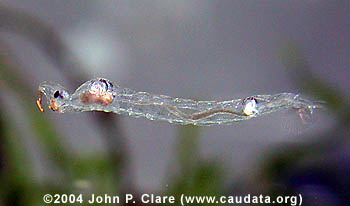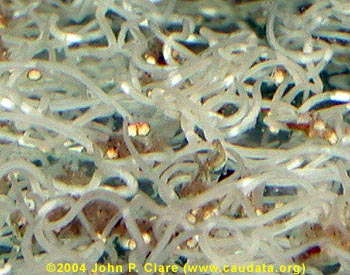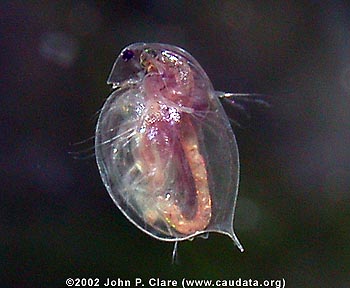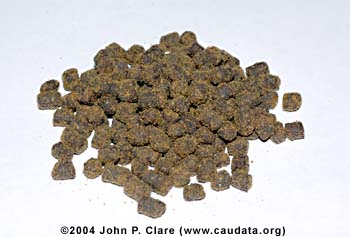| Home | Housing | Feeding | Requirements | Breeding | Biology | Books & Links |

Food for AxolotlsBackground InfoAxolotls are carnivores, implying they require a meat-based diet. They have rather rudimentary teeth, designed for gripping rather than biting or tearing. As a result, their food is generally swallowed whole, so anything they want to eat must fit into their mouths. When a hand-fed axolotl becomes accustomed to people, it may occasionally latch onto a finger. You can feel these little teeth quite distinctly. This is a curious experience, rather than a painful one, because the axolotl hasn't the strength to pierce human skin, so don't be afraid to try it. The Axolotl's teeth come into their own when trying to grip something slippery like an earthworm. The worm will wriggle but it will find it very difficult to escape the Axolotl's mouth. If the worm is too large to swallow completely, the Axolotl will eventually give up and let go. Large food is a problem when you don't have biting teeth! While reading this page, you may find the Health Page worth a look too. It covers some of the dangers of live foods, as well as touching on some nutritional problems. Live "feeder fish" in particular are known to carry disease and are often infected with parasites. These are passed on to whatever eats the fish, and in our case that's our poor axolotl. The name "Ambystoma" means cup-mouth, and axolotls do have large, wide mouths. When an axolotl wants to eat something, it opens its mouth suddenly and water rushes in, along with the food or anything else around (such as parts of other axolotls, or pieces of gravel). This vacuum action often results in a sudden lurch of the axolotl up into the water and then the animal settles down again. Axolotls will eat live or dead food. The movement of live food like a worm is a great stimulus for the axolotl to "snap", and indeed, for newly hatched axolotls movement is the only stimulus to which they will respond. Earthworms are a good food source for adult axolotls, but be sure to get them from a source that doesn't use chemicals (such as an organic garden). Better still, raise them yourself if you have the space. Water-based live foods can be risky because they can be a source of disease. However, if taken from fish-free waters, they tend to be a lot safer (no hosts for the parasites usually means no parasites). Tubifex, although a good food, is not nutritionally balanced for axolotls, and Tubifex can also carry parasites, dangerous bacteria, and other diseases. There are also reports that Tubifex attack salamander eggs. Tubifex are often mistakenly called bloodworms in the US, and shouldn't be confused with the true bloodworms, the larvae of chironomid midges. Freeze-dried and frozen Tubifex are safer than live, although freeze-dried isn't very nutritious.
Bloodworms are midge larvae, and not worms. They get their name from their bright red colouration. They live in the sediments of ponds, where they feed on detritus. They are a very nutritious and well balanced food, but get them from fish-free waters. I find frozen bloodworm cubes indispensable when raising young axolotls, and I heartily recommend them. Blackworms, genus Lumbriculus, are an aquatic relative of earthworms. They are much thinner and smaller than earthworms, and they are a dark brown colour. They have a similarly high nutritional value to that of earthworms, making them a very good choice from that point of view. They can be cultured in captivity, but, at least in the USA, they are commonly and conveniently available in aquarium shops. Wild caught, they can pose the same disease problems as Tubifex, so again, get them from fish-free waters.
Whiteworms, and the closely related Grindal worms, are commonly used to feed juvenile animals. They're a good food source, but they tend to be rather fatty and oily, perhaps because people often feed them with milk-soaked bread. Bloodworms and blackworms can be fed as a staple, provided that there is a little variety occasionally to offset any imbalance, while whiteworms and grindal worms should be used as a treat or a temporary rearing food.
Foods like Daphnia are a good staple, being as nutritionally balanced as brineshrimp. Wild-caught, these still pose a risk of disease. Home-cultured Daphnia, on the other hand, are a great source of food for larval axolotls. Daphnia also make a good treat for axolotls up to 18 cm long (7 inches). Larger axolotls tend not to notice Daphnia. They are also an inexpensive food if home-cultured.
The Indiana University Axolotl Colony, when it still existed, fed its axolotls with high protein and vitamin fortified pellets designed for salmon (5 mm diameter for adults, 3 mm for younger axolotls). The pellets are 45% protein and 20% fat. Following their lead, I tried feeding my axolotls with locally available trout pellets (46% protein, 16% oil). Whether these are pigmented or unpigmented doesn't seem to matter. I found that the axolotls didn't like the hard variant of pellet so make sure your pellets are soft (like those used by the Axolotl Colony). I used to feed axolotls with pieces of beef heart cut into very small strips (0.5 cm wide and about a centimetre long). I've come to believe that beef heart is not a good food for axolotls, despite the widespread documentation of its use. The last time I checked, axolotls do not prey on cows in the wild... I've used Tetra's floating food for turtles and newts, Reptomin. It comes in small sticks. The only problem with these is that they float, and axolotls are less inclined to take floating food than sinking food. Of the four axolotls that I tried with Reptomin, I could only train two to eat directly from the surface on a regular basis. The rest would only do so occasionally. I therefore had to hand feed them Reptomin, and although it's fun initially, it does take a while, hence my switch to pellets. I have used soft sinking salmon feed pellets and I've found them to be well received by the axolotls. These pellets are soft, moist, and retain their shape for a long time. I've fed mealworms to my axolotls, but the chitin (the protein that makes up the hard exoskeleton in insects) is undigestible to the axolotls. Even though I didn't feed many, the filter in-take actually started to clog with little pieces of chitin and I was still picking bits of chitin out of the filter media months afterwards. Apart from this little inconvenience, they're not a complete food, so I would only recommend them as a treat. Brineshrimp are highly nitritious, perhaps more so than any other commonly available food. They provide all of the nutrition needed by axolotls. However, frozen brineshrimp is very messy, and even in live form they are tricky if not eaten quickly - the naupilae, or newly-hatched larvae, tend to die very quickly in freshwater and can foul the water very easily. Frozen brine shrimp comes in cubes and is a good treat. Be sure to remove any waste soon after feeding. Some people use microworms for feeding newly-hatched larvae, and for this purpose they are suitable, if not the most nutritious, of foods. It's conceivable that people could use vinegar eels for this purpose too. One thing to bear in mind when feeding axolotls is that they need high quality foods with low oil and fat contents. They may develop liver problems if constantly fed on foods with a high oil content (Tubifex and whiteworms are a good example). Finally, make sure what you're feeding is balanced in terms of protein and vitamin content. It's no use feeding a high protein food if the Axolotl is not getting enough of one vitamin or another. Unless cited in the Acknowledgements, all text and images are ©1998-2019 John P. Clare. All Rights Reserved. Bookmark Axolotl.org with:
What are these? | ||||||||||||||











 reddit
reddit Facebook
Facebook